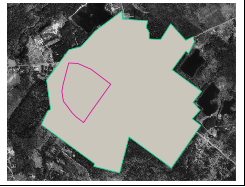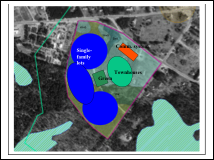 Strategies for Rural Development in Areas with Limited Public Infrastructure: Alternative Septic Systems
Strategies for Rural Development in Areas with Limited Public Infrastructure: Alternative Septic Systems
Case Study 1: Existing Sanitary District
Summary:
A large town in Maine designated a long-settled village section as a growth area. Although other areas of the town are already tied into public sewers and water lines, this area lies outside of the public water and sewer district and there are no plans to extend these services in the future. Within the designated growth area, a 45-acre parcel was developed conventionally by subdividing it into 19 large lots. If this same property had been developed using the assumptions of minimum allowable lot sizes, individual drilled wells on each lot, and a community (i.e., shared) septic system, approximately 56 lots could have been created on the same parcel.
Maine’s Subsurface Wastewater Disposal Rules require that a legal independent entity own and maintain a community septic system. This town already has an existing sanitary sewer district that could assume responsibility for operation and maintenance of the new system, even though it lies outside of the existing system boundaries. In this hypothetical case, the developer would construct the community wastewater disposal system at his or her cost, to be recovered through sales of the individual lots. After the system was completed and approved for operation, the developer would turn it over to the sanitary district, along with additional land to be held in reserve for system expansion or replacement. The sanitary district would then operate and maintain the system and charge user fees to each lot owner to cover its costs, just as it does for properties on the existing public sewer line.
Case Study One Details
The Setting: In Case One, the community is a well-established suburb. It is a geographically large town. A portion of the community is densely developed and served by public water and public sewer utilities, which are managed by chartered districts. But the community also has an extensive rural area, a small part of which is a long-settled hamlet with a concentration of homes and several small businesses. Adjacent to the village is vacant land with potential (and an increasing demand) for growth. The town’s comprehensive plan has designated this hamlet as a growth area, even though it has neither public water nor sewer. Extension of public water and sewer lines will not occur in the foreseeable future.
The Conditions: The growth area contains approximately 433 acres (see photo). Of this acreage, approximately 200 to 250 acres already are occupied with an estimated 100 to 125 single-family homes (assigning an average of two acres per lot). About 85 acres are vacant but unbuildable due to wetlands, water table at the surface,

and other natural limitations. This leaves 100 to 150 buildable acres. The area lies on top of a moderate production (10 to 50 gallons per minute) sand and gravel aquifer, but there are no public wells in the area.
The buildable areas are dominated by deep, well-drained soils. In some cases the seasonally high water table is more than 48 inches below the surface, and in other cases the seasonally high water table is 18 inches to 30 inches below the surface. Some of the vacant, buildable land is contained in oversized lots of five to 20 acres, developed with just one single-family home per lot. Other vacant land is in larger parcels of 25+ acres.
Estimating Building Potential: To illustrate this case study, and to contrast the potential of a community wastewater system with the large-lot model that is currently being employed in this growth area, we have selected a tract of about 45 acres that was developed as a contemporary subdivision with 19 lots, averaging about two acres per lot.
The primary soil types on the site are an excessively drained loamy sand (depth to both seasonal high water table and bedrock, more than five feet) and a moderately well-drained loamy sand (seasonal high water table at 18 to 30 inches, depth to bedrock more than five feet). About six acres are very poorly drained, or have a high water table year-round. The site is not limited by any steep slopes.
A community wastewater system (also known as a “clustered” or “shared” system) could be located on a relatively flat area of the site, characterized by glacial outwash soils. This would require a medium-sized disposal field under Maine’s Subsurface Wastewater Disposal Rules. However, this town – reflecting unfounded fears shared by many Maine communities – prohibits community systems over sand and gravel aquifers, because “eventually they can become maintenance problems” and lead to “pressure to extend public sewer lines to solve the problem.” (To offer a real-world contradiction of this widely held belief, the Town of Brownville operates and maintains 12 acres of community wastewater disposal fields directly over the sand and gravel aquifer that the town uses for its drinking water, and has done so while maintaining excellent drinking water quality for almost 25 years.) The management approach described in this hypothetical case study is aimed at resolving the concern about potential drinking water contamination.
The case study assumes placement of a drilled well for drinking water on each lot. No well could be located within 300 feet of the community leach fields, because of their large size. At a design flow of 10,000 gallons per day (approximately 37 3-bedroom homes), the site would need to dedicate 36,000 square feet (0.83 ac) of area for two leach fields for the community system, 20 feet apart. At a design flow of 20,000 gallons per day (74 homes), the site would need to dedicate 134,000 square feet (3.1 ac) of area for 4 leach fields, each 20 feet apart. (Note: these calculations include all required minimum separation distances from property lines, wells, and water bodies.) The area could be reduced even further with the use of proprietary wastewater treatment system components, rather than the traditional stone beds.
Under the state’s Minimum Lot Size Law, the case study site could theoretically accommodate (with or without a community wastewater system) as many as 97 units (44.5 acres times 43,560 sq. ft., divided by 20,000 sq. ft. per unit). It is assumed, for purposes of this case study, that the units are single family homes and perhaps some townhouses. The leach fields, roads serving the development, and other unbuildable portions of the tract are not required by the Minimum Lot Size Law to be subtracted from the gross acreage before calculating the allowable number of units. Most local zoning ordinances, however, do impose a “net acreage” rule. Further, the required distances between the community leach fields and individual wells would impose an additional practical limitation to the creation of lots. Finally, as discussed below, a sanitary district is unlikely to accept ownership and management of a community wastewater system unless the developer provides reserve space for at least one additional leach field, as a guarantee against the need for future land purchases to repair, replace, or expand the system.
All of these limitations reduce the practical number of potential lots and units on this site to approximately 56, occupying 31 of the tract’s 45 acres. The average density would be about 1.5 units per net acre, and 1.2 units per gross acre. If the town’s ordinances permitted a community system to be installed above a sand and gravel aquifer, the parcel in this case study could have safely accommodated more than three times the number of units that were actually built using onsite septic systems.
The “bubble” diagram below illustrated a traditional neighborhood layout using a community wastewater system. This neighborhood includes a mix of townhouses and single family homes surrounding a green, with poorly-draining soils near the front of the site reserved for open space.

Managing the System: Maine’s Subsurface Wastewater Disposal Rules require that a “single and independent” entity own and maintain a community wastewater system. This reflects the legitimate concern that community wastewater systems will not achieve desired treatment standards without proper operation and long-term maintenance. The entity must own all parts of the system beyond each building’s backflow valve – that is, all parts from the point of discharge to a septic tank and disposal field. The entity must have the authority and responsibility to operate, maintain, repair, and if necessary replace the system beyond the individual building’s plumbing. It must have the authority to charge maintenance and other fees to assure sufficient capitalization to meet its responsibility; have access easements recorded against the properties using the system; and have the right of entry to all properties for the purpose of maintaining, repairing, or replacing any portion of the common system.
In the past, community systems have been constructed primarily for leased-land developments under single ownership such as mobile home parks, or for condominium communities in which participation in a legally established homeowners’ association is both mandatory and expected. In this case study, a homeowners’ association could certainly be formed and designated as the legal entity to own and maintain the community wastewater system. It would need to be established by the developer and approved by the local planning board at the time of approval of the subdivision, and would be vested with the required powers and responsibilities.
The problem with this solution is that a homeowners’ association may have neither the technical know-how nor the administrative resources to properly manage a community septic system over the long term, despite good intentions and a legal mandate. Shared ownership of common infrastructure is still the exception rather than the rule in single-family residential subdivisions in Maine, and allotting time and money to septic system maintenance would be unlikely to strike the volunteer board of a homeowners’ association as a top priority…that is, until the systems began to fail. To be successful over the long term, community septic system management practices must dovetail with traditional and accepted models of residential and commercial development.
For example, in this case study there is an existing sanitary district that maintains the sewered portions of the town. Maine law allows the establishment of a relationship between an existing sanitary district and any new development for purposes of managing its community wastewater disposal system, even if the system lies outside of the established boundaries of the district – or even outside the boundaries of the town where the development is located. Obviously, practical considerations dictate that the management entity should be located close enough to the development to permit convenient travel and periodic inspections by sanitary district employees.
Implementing the system: In this case study, the implementation plan for the new subdivision could follow this sequence:
Design and construction of the community wastewater system by the developer at his or her cost (recovered through sale of the lots), according to specifications of the Subsurface Wastewater Disposal Rules.
- An up-front arrangement in which the sanitary district jointly inspects the system with the local plumbing inspector as it is being constructed.
- Dedication by the developer of all parts of the completed system (including septic tanks, lines, pumps, and leach fields) to the sanitary district, analogous to the dedication of all public sewer lines in the extension of a conventional sewer system. The developer should discuss the location of septic tanks and lines with the sanitary district at the time of the design of the system, and the town’s planning board should require written evidence of approval of the system by the sanitary district prior to subdivision approval. The sanitary district will want to ensure that all necessary easements are in place, to ensure legal access to each individual property and system component that ties into the system. Further, the sanitary district should require additional land to be set aside for future use, in case repair or replacement of the leach fields are required.
- Maintenance of the system by the sanitary district, with user fees charged to the property owners. (Charges may be either flat fee, or metered to encourage water conservation.) The sanitary district manager in the case study commented that fee assessment and related administrative aspects for the subdivision could be readily absorbed into his district’s existing metering and payment system.
Alternatively, the sanitary district could maintain the community wastewater system under direct contract with the homeowners’ association. In that case, the homeowners’ association would be the responsible legal entity, but a condition of the planning board’s approval of the system and the subdivision would be the establishment of a long-term maintenance contract with the district. The association would collect fees from homeowners to pay for the contracted services.
In summary, the essence of this approach is to take advantage of an existing nearby sanitary district (which need not even be located in the host community) to ensure professional, long-term management of community wastewater systems. This is an effective way to guard against contamination of the sand and gravel aquifer, while still allowing for increased density to encourage land development within the designated growth area of the town.
Related Work Plan Components
- Climate Change and Infrastructure Resilience
- Modernizing Communications/Electric Utility Infrastructure
Workgroup Contacts
In Aroostook County: Jay Kamm, Ken Murchison, Joella Theriault
In Washington County: Judy East

Share this content: